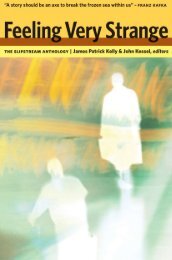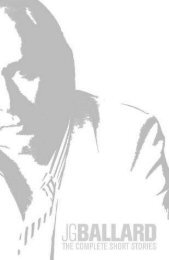The Curse of the Wer.. - Site de Thomas - Free
The Curse of the Wer.. - Site de Thomas - Free
The Curse of the Wer.. - Site de Thomas - Free
Create successful ePaper yourself
Turn your PDF publications into a flip-book with our unique Google optimized e-Paper software.
80 THE CURSE OF THE WEREWOLF<br />
<strong>of</strong> a ‘natural’ or<strong>de</strong>r in which power and authority are conferred by<br />
birthright — a line <strong>of</strong> thought which led to <strong>the</strong> French Revolution. In<br />
keeping with <strong>the</strong> new focus on subjectivity or <strong>the</strong> <strong>de</strong>velopment and perfection<br />
<strong>of</strong> <strong>the</strong> self, male power was now constructed not as <strong>the</strong> ‘natural’<br />
right <strong>of</strong> a man but, ra<strong>the</strong>r, as something that must be entered into or<br />
acquired through processes <strong>of</strong> quest, crisis and resolution. Because<br />
male subjectivity was increasingly imagined in terms <strong>of</strong> psychic division,<br />
this process <strong>of</strong> accession became linked to <strong>the</strong> success with which<br />
a man was able to ‘discipline’ his bestial, unconscious drives, through<br />
narratives such as <strong>The</strong> Wolf Man. Subsequent cinematic representations<br />
<strong>of</strong> <strong>the</strong> werewolf have regularly <strong>de</strong>picted masculine protagonists<br />
who sud<strong>de</strong>nly find that <strong>the</strong> crisis <strong>of</strong> subjectivity represented by <strong>the</strong><br />
eruption <strong>of</strong> <strong>the</strong> ‘beast within’ also calls into question <strong>the</strong>ir social<br />
i<strong>de</strong>ntity and authority.<br />
As a result, <strong>the</strong> cinematic werewolf has become a perennial figure<br />
<strong>of</strong> masculine crisis; Hammer Film’s <strong>Curse</strong> <strong>of</strong> <strong>the</strong> <strong>Wer</strong>ewolf (1960, UK),<br />
starring an anguished Oliver Reed, encapsulates in its title all that<br />
lycanthropy had come to signify for masculinity. So familiar has this<br />
narrative become that <strong>the</strong> inci<strong>de</strong>ntal werewolf character in <strong>The</strong> Monster<br />
Squad (1987, USA) is introduced in <strong>the</strong> background at a police station<br />
while two more important characters engage in dialogue, but <strong>the</strong> man’s<br />
insistent ‘Lock me up — I’m a werewolf, I’m a werewolf’ is all viewers<br />
require to grasp <strong>the</strong> scenario. Around two-thirds <strong>of</strong> films featuring<br />
werewolves have relied upon <strong>the</strong> narrative structure established in<br />
<strong>the</strong> 1930s and early 1940s, in which a respectable, white, heterosexual<br />
man is acci<strong>de</strong>ntally afflicted with lycanthropy, suffering trauma and<br />
anxiety as a result. <strong>The</strong> presumption that a werewolf must be male<br />
(‘Who ever heard <strong>of</strong> a girl werewolf?’ asks Cindy, a character in a<br />
children’s werewolf story 42 ) is most manifest in films which feature an<br />
inci<strong>de</strong>ntal werewolf as a minor or supporting character. Because <strong>the</strong>se<br />
films are not exclusively focused on <strong>the</strong> werewolf <strong>the</strong>me, <strong>the</strong>y tend to<br />
resort to a shorthand iconography <strong>of</strong> lycanthropy, presenting viewers<br />
with a <strong>de</strong>fault version <strong>of</strong> <strong>the</strong> werewolf that is invariably male. 43 Just<br />
as tellingly, o<strong>the</strong>r films reveal female lycanthropy as a ‘twist’, as in<br />
Dog Soldiers (2002, UK), in which <strong>the</strong> local Scottish girl who gives





